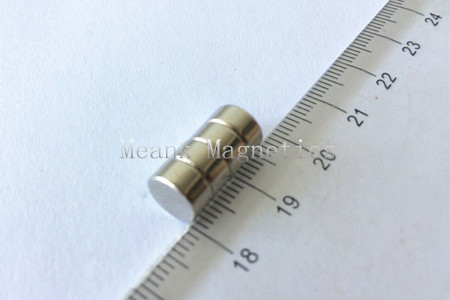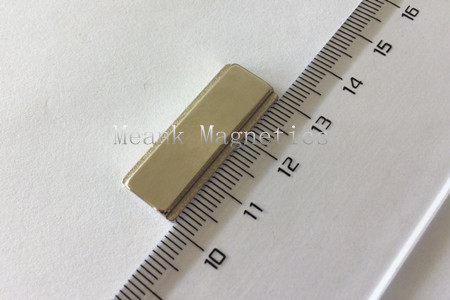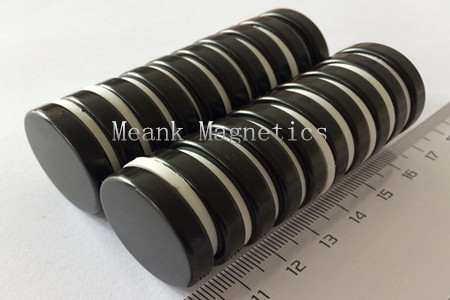Definition of arc magnet: arc magnet also called as magnetic tile, it is a kind of
permanent magnet in the tile shape, mainly used on permanent magnet motor.
Classification of arc magnets: there are four main categories of arc magnets according to its raw material:
1. Ferrite arc magnets which made from ceramic magnets, also called as ceramic arc magnets.
2.
Neodymium arc magnets which made from NdFeB rare earth magnetic material.
3. AlNiCo arc magnets which made from AlNiCo magnetic material.
4. SmCo arc magnets which made from Samarium-Cobalt rare earth magnetic material.
Use of arc magnets: Arc magnets are mainly used in permanent magnet DC motor. It is different from electromagnetic motor to produce magnetic potential source through excitation coil. Permanent magnet motor produces constant magnetic potential source with permanent magnet material. Permanent magnet arcs instead of electric excitation have many advantages, which can make the motor simple, easy to repair, lightweight, small in size, reliable in use, less copper, low copper consumption and less energy consumption.
Influence of performance of arc magnets on Motor
1. High residual magnetic induction strength Br. Because high Br can ensure the motor has higher speed, large output torque and high power. The motor will have higher efficiency.
2. High HCB. Because of the high Hcb, the electromotive force needed for the output of the motor can be ensured, the working point of the motor is close to the maximum magnetic energy product, and the ability of the magnet can be fully utilized.
3. High Hcj. High Hcj can ensure strong resistance to overload demagnetization, anti-aging and low temperature resistance.
4. High(BH)max. The higher the (BH) max is, the better the working coefficient of the permanent magnet ferrite in the motor is.
5. The larger the magnetic flux, the better, which will greatly improve the working efficiency of the motor.
6. The better the rectangle of demagnetization curve, the smaller the dynamic loss of motor.
7. The higher the resistivity of permanent magnetic ferrite, the smaller the eddy current loss.
8. The temperature coefficient of permanent magnet ferrite is small, and it has good temperature stability at high temperature.
Brief history of development for arc magnets
The development of the arc magnets is based on the needs of the permanent magnet motor itself.
1. Permanent magnet motor is divided into permanent magnet DC motor and permanent magnet AC motor.
1.1 Permanent magnet AC motor refers to multi-phase synchronous motor with permanent magnet rotor. Formerly, ferrite arc magnets and aluminum-nickel-cobalt arc magnets are mainly used. With the higher power requirements, the ferrite arc and alnico arc cannot meet the requirements because of the low magnetic energy product. Now the
NdFeB arc magnets are widely used in the field of high power synchronous motor and generator. Of course, NdFeB arc magnets, because rare earth resource is precious, raw material price rises exponentially, its manufacturing cost and production price will continue to rise in the future, affect its extensive use in some low-end domain. The negative temperature coefficient of NdFeB permanent magnet and the low Curie temperature also limit its application in high temperature.
1.2 Permanent magnet DC motor is divided into brushless motor and commutator DC motor. Its application is judged by the shape and pole number of magnet. In the ordinary DC motor, the two and four poles are mostly used, and the arc magnets is basically used as the stator of the motor. The miniature DC motor mostly uses ferrite arc magnetic , which is mainly used in the fields of toys, household appliances and automobiles. When brushless motor uses arc magnets as stator, it is usually more than 6 poles, so its center angle is much smaller than that of ordinary DC motor. However, as the rotor of brushless motor, the arc magnets can have more than 4 poles. For the four poles, the rotor is magnetized on the outer surface, and the center angle of the rotor is close to 90 °because it has to be assembled into a circle. This can be distinguished from the ordinary DC motor.
2. According to the application field, the arc magnet has different requirements for the performance and magnetic field waveform. As a rotor field, the external arc meter requires high field, the waveform basically requires sine wave, and as the stator, the output force of the motor is required. The different requirements of spark and noise are selected, and the inner arc meter field is high, because of the shape and production characteristics of the magnetic arc, the waveform is mainly saddle, the waveform of this kind of waveform is large, but the spark noise and the no-load current are large. In order to improve vibration and noise, reverse spark, reduce no-load current, shape and size of magnets, die design and so on, etc., arc magnets with unequal thickness has been widely used. The principle of this method is to make the magnetic waveform of the arc air gap of the arc magnets tend to the flat-top wave.
3. Special use of arc magnets: during the 80s and 90s, the magnetization cup was popular. The magnetic tile was used as magnetic field source of magnetized cup. At that time the domestic ferrite magnetic tile demand is also very small.
Production process:
According to the materials and types of magnetic tile, its process is also very different. Ferrite tile is mainly made from sintered ferrite, NdFeB arc magnets can be divided into two categories: sintered neodymium arc magnets and bonded neodymium arc magnets.
1. The production process of sintered ferrite magnetic tile is mainly divided into wet pressure, dry pressure and dry pressure. The difference between anisotropic and the isotropic lies in whether there is an oriented magnetic field in the forming process of the press. Here mainly introduces the technology of wet pressure.The wet pressing process is as follows: raw material→presintering→coarse comminution (primary ball milling)→batching→secondary ball milling (wet grinding)→ magnetic field forming→sintering→grinding→cleaning→magnetizing.
2. Sintered NdFeB magnetic tile: proportioning→melting→crushing→pulverizing→magnetic field forming→isostatic pressure→vacuum sintering and tempering→wire cutting processing→electroplating→magnetizing




